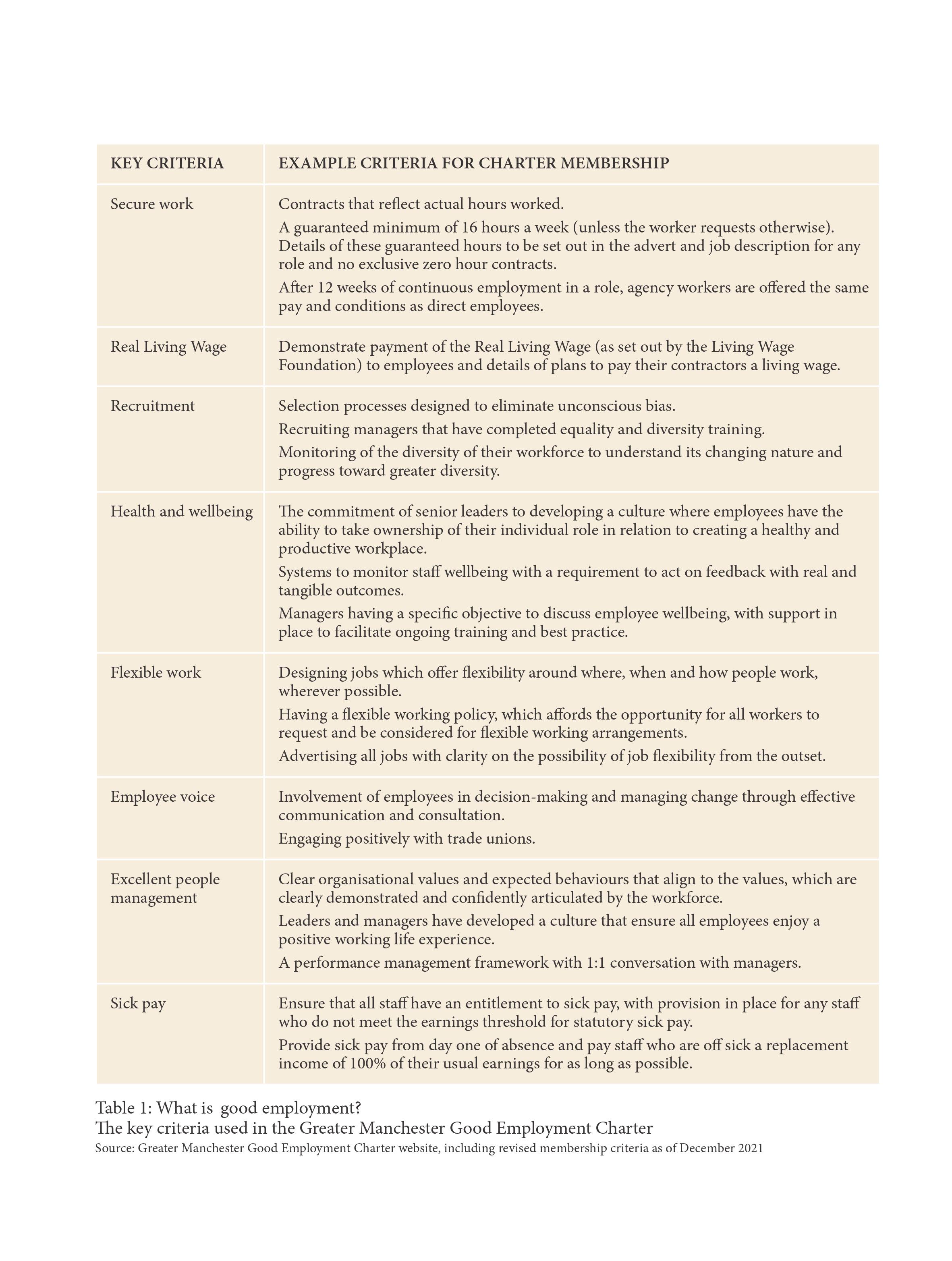On Productivity
Analysis and ideas on addressing the gaps in economic performance across the UK

Foreward
Gemma Tetlow
The promise to level up the UK was one of the flagship promises made in the 2019 Conservative manifesto. This pledge tapped into a longstanding sore in British society – the stubborn gap in economic performance and many other measures of prosperity between different parts of the UK, and in particular between London and the South East and the rest.
But, while the problems may be obvious, the solutions have been more elusive. Successive governments over the past few decades have tried to tackle these productivity gaps. Tony Blair’s government introduced regional development agencies, George Osborne had his Northern Powerhouse agenda and Theresa May championed the Midlands Engine. Despite these initiatives, the productivity gaps remain.
If the current government is to make meaningful progress where its predecessors have failed, it is vital that it learns from the evidence on what has and has not worked before and how local circumstances affect what policies are required and whether or not they will be successful. This report, ‘On Productivity’, therefore provides a valuable contribution to policymakers – synthesising the evidence on what has and has not worked to boost productivity and highlighting how the issues play out in Greater Manchester.
As the chapters in this report demonstrate, addressing gaps in productivity across the country is likely to entail a wide variety of policy levers – from policies to boost skills and health to changes to governance structures. It will also require central government working constructively with subnational governments and the private sector. The government has set out big ambitions, now it is time to deliver.
Gemma Tetlow is Chief Economist at the Institute for Government, the leading think tank working to make government more effective. She has over 15 years’ experience analysing and commenting on public policy, as a researcher and a journalist.


Go, go gadget Manchester? How can we turn gadgets into productivity?
Professor Bart van Ark

Manchester and the surrounding areas were at the heart of the Industrial Revolution in the late 18th and early 19th century. But the city, and northern England as a whole, is not at the centre of today’s digital revolution. Can the north regain a prominent role in the fourth Industrial Revolution?
Take a walk through the Manchester Science and Industry Museum and you’ll see fine examples of the steam engines and textile looms that were at the heart of the first industrial revolution. In T.S. Ashton’s, The Industrial Revolution, 1760-1830 the schoolboy said that “a wave of gadgets swept over England”. But while the impressive machines dramatically raised the efficiency of workers, which is one way to define productivity, it took a lot more than machines to increase wealth and raise people’s living standards. Indeed, as the 19th century unfolded, the north of England underwent a massive economic, social and cultural transformation which literally changed the landscape from a rural, agrarian society into an urban, industrial society. It changed how people worked, were educated, lived together, and became physically and socially more mobile.
The same cannot be said of today’s fourth Industrial Revolution. While we are inundated with new digital devices and technologies to collect, process and distribute digitized information at amazing speeds, has the fourth revolution made us all better off? In 1987, Nobel Prize winning economist, Robert Solow once quipped: “You can see the computer age everywhere but in the productivity statistics.” This can also be said of latest digital technologies, including artificial intelligence and robotics, which haven’t seen the widespread economic benefits one might have hoped for.
Indeed, productivity growth has seen one of the largest slowdowns ever measured over the past 15 years. Growth in output per hour in OECD countries halved from almost 2% per year on average between 1995 and 2007 to just 1% between 2008 and 2019. There is no single explanation for this historic slowdown. The drag from the global financial crisis has been manifest through low demand and weak investment, too low interest rates causing misallocations an overreliance on cheap labour, and failing fiscal policies. There has been a weakening of globalization as measured by trade and FDI. The low-hanging fruit from innovations from previous technology waves may have been largely picked, whereas we don’t yet have productive answers to the new challenges facing us, such as climate change or aging populations. A weakening in productivity gains in the aftermath of technological revolutions has been experienced before, but the current figures show an unprecedented slowdown compared to previous eras. While measurement of digital outputs and inputs may be imperfect and causing some underestimation of the true productivity growth rate, there is broad consensus among researchers that this won’t explain the slowdown in full.
In the UK, the productivity record has been among the worst in the OECD. Output per hour worked grew at a snail pace of 0.5% per year on average from 2008–2019 compared to 1.8% from 1995–2007. One of the main reasons for the exceptionally poor productivity record of the UK is a decades-long underinvestment in the key drivers of productivity growth. For example, the UK is in the bottom third of OECD countries for the share of output going to fixed capital formation, R&D spending, and hard and soft infrastructure investment.
There is also much variation in productivity within the UK, across devolved nations, regions, and city areas, which is large by international standards. While UK productivity growth was a meagre 0.5% per year nation-wide, it increased at only half of that in the north-east, it stalled in the north-west, and declined in Yorkshire and the Humber over the past decade. The strong productivity performance of the London metropolitan area plays an important role in understanding the regional inequalities, but there are also concerns about the unusual weak productivity record of second tier cities, including Manchester but also Birmingham, Sheffield and Leeds relative to comparable cities in other countries. For example, the level of output per hour in both Greater Manchester and Birmingham was not only just 68% of that in London, but also almost a quarter or more below peer cities in Western Europe.
Long-term scarring from the north-west’s industrial decline is undoubtedly one explanation why the region has been trapped for so long in a low-investment, low-skill, low-productivity equilibrium. When the region’s economy slowly recovered during the 1990s it was built on weak fundamentals. De-industrialisation had caused an exodus of young and skilled people, a closure of financial and commercial firms, high unemployment, ill-health and deprivation. This has been further compounded by the UK’s centralised and functionally fragmented decision-making structures which do not recognise local circumstances and stifle regional and local initiatives.
So where do we go from here? Recently, The Productivity Institute’s North West Productivity Forum identified several policy priorities in strengthening productivity. One area of focus is to advance digital transformation by leveraging digital technologies and the data they produce to connect organisations, people, physical assets and processes, to create a technologically diverse, sustainable and productive economy. The diffusion and absorption of digital technologies is equally important as the actual creation of it. For example, The Made Smarter programme helps manufacturing firms in the north-west with new digital tools and technologies by emphasising management competencies, supporting technology diffusion through supply chains, building stronger digital innovation eco-systems, and strengthening current and future skills. It will be important to take the lessons from this pilot, as well as from other city-based initiatives supporting firms to adopt new technologies such as LCR4.0 in the Liverpool City Region. Stronger within-region connectivity to strengthen agglomeration effects (Transport for the North) and improved coordination and collaboration on policies at all levels of government to build effective digital innovation ecosystems across the region are also critical ingredients to digital transformation.
Walking out of the Manchester Science & Industry Museum, which houses all the gadgets of the past, you’ll see the reality of today’s challenges and opportunities which the city, like so many places in the north, is facing. The old train station from the world’s first railway that linked Manchester and Liverpool is today renovated and houses the museum itself. The surrounding buildings are a mix of old warehouses, renovated and repurposed, alongside new developments aiming to launch Manchester into the digital age. It shows that vibrancy can be won back but that it is a subtle play of building on a place’s strengths, revitalizing old structures and institutions, and making some bets in creating opportunities for the future.
The government’s Levelling Up White Paper breathes a clear understanding of the many pieces of the puzzle that need to fit together. It even labels digital connectivity to drive pay, employment and productivity across the nation as the first of its twelve missions. The parallel with the “Medici model” of Renaissance Florence combining the traits of science, entrepreneurship and resources is interesting, and the long-term focus of the white paper on 2030 is good. But the scale and complexity of the challenge needs a roadmap with clear targets and intermediate steps and mechanisms to deal with conflicting goals, which is still largely absent. Indeed with the gadgets at our disposal, we need consistent policies to connect place, people and product to revive the economies of Manchester and beyond.
Policy Recommendations
· Prioritise digital transformation by leveraging digital technologies and the data they produce to connect organisations, people, physical assets and processes, to create a technologically diverse, sustainable and productive economy. This diffusion and absorption of digital technologies is equally important as the actual creation of it.
· Strengthen within-region connectivity to improve agglomeration effects alongside better collaboration between levels of government to build effective digital innovation ecosystems across the region.
· The government’s Levelling Up White Paper breathes a clear understanding of the many pieces of the puzzle that need to fit together. But the scale and complexity of the challenge needs a roadmap with clear targets and intermediate steps. With the gadgets at our disposal, we need consistent policies to connect place, people and product to revive the economies of Manchester and beyond.
Bart van Ark is a Professor of Productivity Studies at the Alliance Manchester Business School, The University of Manchester. He is the Managing Director of The Productivity Institute, an ESRC-funded nation-wide research organisation exploring the UK’s productivity shortfall and the means to improve it.



Health inequalities and regional productivity
Dr Luke Munford and Professor Clare Bambra

The renewed effort to ‘Level Up’ England is essential, as there are deep-rooted and persistent regional inequalities. People living in the north of England typically perform less well than those living in the rest of England on many important metrics. Crucially, the health of people living in the north is lower and so is their economic performance, often through no fault of their own. Previous policy has advocated for economic reforms with the hope that health will improve too. Here, we argue that health is an important pre-requisite for economic performance, and therefore, there needs to be a bigger focus on ‘Levelling Up’ health.
Regional differences in economic productivity and wealth before COVID-19
Pre-COVID-19, there was a £4 per-person-per-hour difference in productivity (measured using average Gross Value Added; GVA) between people living in the north of England and the rest of England; the average GVA per-worker in the north was £28 per-hour, compared to £32 nationally.
Based on these estimates, if Levelling Up the regions of the UK increases the productivity in the north to match the UK average, it would equate to a potential £44 billion real term gain to UK GDP.
The north experiences lower levels of economic activity rates, implying higher rates of unemployment and economic inactivity. Job density is lower too; for every 100 people looking for a job in the north, there are only 79 available – in London, the corresponding figure is 102. Even when in employment, the average annual earnings in the north are 10% lower than the rest of England.
Regional differences in health before COVID-19
People who live in the north tend to have lower levels of health than elsewhere and there is a two-year gap in life-expectancy. Over the last 50 years, over 1.5 million northerners died earlier than if they had experienced the same lifetime health chances as those in the rest of England.
There are also marked differences in the quality of health in the north. The ‘Due North Inquiry’ into health equity reported that a baby boy born in Manchester can expect to live 17 fewer years in good health than a baby boy born in Richmond upon Thames. A baby girl born in Manchester can expect to live 15 fewer years in good health than a baby girl born in Richmond.
The relationship between health and productivity before COVID-19
In a 2018 report funded through the Northern Health Science Alliance (NHSA), we asked “Are these things connected? If we reduce the regional differences in health, will we benefit from higher productivity?”
We showed overwhelmingly that they were. Large economic benefits will follow from the improvement of the health of those living in the north of England. This entails the improvement of employment rates, wages, and in turn, productivity. Potential channels through which health can improve productivity and economic performance include a healthier workforce, who are more likely to be employed and stay employed. Healthier people are also more productive in their job, through a combination of increased happiness and fewer ‘sick days’.
We also examined how much of the ‘productivity gap’ could be explained by lower levels of health in the north. Around 30% of the productivity gap (of £4 per-person-per-hour, or £44bn per-year) can be directly attributable to worse health in the north. If we were to eradicate this gap and truly ‘Level Up’ health, we estimated that a further £13.2 billion per-year could be added to the UK GDP. This was likely a conservative underestimate as health also indirectly affects productivity through education, training and skills.
What happened during COVID-19
Analysis of data showed that the north was harder hit by the COVID-19 pandemic than other regions of England. The COVID-19 mortality rate was 17% higher in the north as a whole (38% higher in Greater Manchester and 59% higher in Manchester). All-cause mortality was much higher in the north, and we estimated that over two-thirds of the excess northern mortality – or about 100 deaths per 100,000 population, equivalent to around 15,500 deaths in total in the north – could potentially have been prevented if pre-pandemic health and deprivation was the same in the north as in the rest of the country. The prevalence of mental health conditions also rose sharply in the north, in part explained by more exposure to stricter localised lockdown measures.
The economy of the north was also harder hit. Unemployment rates were higher, and they rose much faster; the average unemployment rate of the north was 10% above that of the rest of the country during the pandemic. Wages of people in the north fell too.
We estimate that the increased mortality in the north of England could cost the national economy up to £7.3 billion in lost productivity. This will also likely to be a conservative underestimate given the north’s economy has also been hardest hit.
It is paramount to place health at the centre of all Levelling Up agendas. There needs to be a recommitment to a ‘health in all policies’ position and there to be a national strategy to target and reduce both between and within regional inequalities.
The central government can focus on mitigating health inequalities by addressing an array of issues.
· Firstly, it should improve health in the north by increasing investment in place-based public health. Local communities are in a much better place to know what works and why. For example, a key component of New Labour’s English health inequalities strategy was area-based interventions (such as Health Action Zones), and this led to a reduction in health inequalities.
· Secondly, it should work with employers to improve labour market participation and job retention amongst people with health conditions in the north. For example, people who have long-term conditions could be given extra assistance to enable them to maintain their job. This could include different working arrangements, easier availability of necessary equipment, and greater flexibility.
· The central government should also increase NHS funding in the north to be spent on prevention services and health science research. The increases in spending could be brought about by, for example, giving a higher weighting to deprivation measures.
· Fourth, by implanting an inclusive, green industrial strategy, the economic inequality between the north and the rest of England can be reduced.
· Our last suggestion for government is health remains a key part of the Levelling Up and Regeneration Bill. The commitment to increase healthy life expectancy was good to see, but more details on how it plans to do this would have been welcomed. In terms of northern, local, and regional stakeholders, we recommend the development of health promotion and prevention services. This can be done through via Health and Wellbeing Boards and the emerging NHS integrated care systems. We also recommend that Local Enterprise Partnerships, local authorities and devolved northern regions should develop locally-tailored programmes in partnership with the local NHS and third sector providers to promote ‘health-first’ programmes. Finally, local businesses should be encouraged by government initiatives to support job retention and health promotion interventions across the northern workforce and northern city regions.
Policy Recommendations
· Improve health in the north by increasing investment in place-based public health. Local communities are in a much better place to know what works and why. For example, a key component of New Labour’s English health inequalities strategy was area-based interventions (such as Health Action Zones), and this led to a reduction in health inequalities.
· Work with employers to improve labour market participation and job retention amongst people with health conditions in the north. For example, people who have long-term conditions could be given extra assistance to enable them to maintain their job. This could include different working arrangements, easier availability of necessary equipment, and greater flexibility.
· Health must remain a key part of the Levelling Up and Regeneration Bill. The commitment to increase healthy life expectancy was good to see. In terms of northern, local, and regional stakeholders, we recommend the development of health promotion and prevention services. This can be done through via Health and Wellbeing Boards and the emerging NHS integrated care systems.
Luke Munford is a Senior Lecturer in Health Economics at The University of Manchester. His research investigates the causes and consequences of health inequalities.
Clare Bambra (PhD, FAcSS) is a Professor of Public Health at the Population Health Sciences Institute at Newcastle University. She is an interdisciplinary social scientist working at the interface of public health policy, health geography and social epidemiology. Her mixed methods research focuses on understanding and reducing health inequalities.


Gender equality and the productivity agenda
Professor Jill Rubery

Raising productivity is now the key route to achieving the government’s announced goals of a high wage, high productivity economy and levelling up between and within regions. The implications for gender equality are, however, rarely discussed. A key issue is whether these productivity and levelling up policy agendas will address the underutilisation of women’s potential and the undervaluation of women’s work. So far there appears to be little interest in gender equality issues - the only mentions of gender in the Levelling Up White Paper is in relation to healthy life expectancy, where women tend to do better than men. There is scope for these agendas to contribute to gender equality as well as reduced spatial inequalities. Yet a simple focus on productivity will not necessarily deliver improved gender equality, nor will improvements in gender equality always increase measured productivity. Adopting a gender equality lens thus requires a reconsideration of how we measure and think about productivity.
The underutilisation of women’s potential is evident in women’s lower employment rates. Despite rising steadily, they still fall below the male average (71.8% compared to 78.2% October to December 2020). This employment gap of 6.3 percentage points is lower than the 10.4 percentage points gap a decade ago but OECD data on full-time equivalent employment rates shows a much larger gap of 23.5 percentage points (57.6 for women compared to 81.1 for men in 2019).
Although women make voluntary choices to work part-time, in practice these choices are constrained by employment practices, social norms and a lack of social infrastructure. More women would enter employment or work longer hours if there were better job prospects, fewer requirements for full-time workers to work extended or unpredictable hours, if childcare was more flexible and affordable, and public transport more reliable and plentiful.
Extending opportunities for jobs and for longer hours should boost national and local area growth. The Eurofound estimates that closing the gender employment gap would boost EU GDP by 2.8%, even if restricted to those women not in employment who currently want to work. However, the impact on measured productivity is more ambiguous. Productivity measured as output or value added for each hour of paid labour is argued to be the main route to higher living standards. Yet living standards can also be enhanced by raising employment rates and hours of work. Increasing women’s paid work hours could initially lower productivity, as it is the lower skilled whose employment rates are the most depressed and who are therefore likely to dominate new entrants and those extending hours. In the longer term, more continuous employment and longer guaranteed hours for part-timers should boost productivity by enabling better skill development. Paradoxically, in the short term productivity per hour could decline, as jobs organised on a flexible basis have allowed employers only to pay for those hours where demand is high, thereby raising productivity per hour through higher work intensity. However, this only benefits employers as workers may have to spend unpaid time waiting for or searching for work.
Focusing solely on maximising measured productivity per hour does not automatically improve living standards and security for women or for low-income households. Admittedly, increasing high productivity jobs in left-behind areas would have some indirect positive demand effect on services that would draw more women into employment. Yet, real progress in levelling up by both gender and local area requires more emphasis on ‘soft infrastructure’ investment such as childcare and more efforts to end insecure contracts than is present in current plans.
The underutilisation of women’s talents is also evident in relation to both skills and progression opportunities. Problems emerge at all levels in the labour market. For graduates in their first job, there is already a gender pay gap that is not accounted for by subject specialism or degree level. This gap widens over time, particularly if women switch to part-time working and are put on a ‘mommy’ career track without opportunities for training or promotion. Women are also overrepresented in the low-paid segment of employment where most part-time jobs are concentrated. This segment is characterised by low progression and development opportunities.
How skill underutilisation impacts measured productivity is variable. Failure to develop and utilise women’s talents must impoverish our economy and society. Some female-dominated sectors that provide limited pay progression opportunities – for example in social care – still rely on women developing and utilising skills gained through experience. Here productivity is enhanced through the unrecognised skills of the workforce, not from the firm’s super managerial skills.
Thus, what might appear to be women’s underutilisation in low skilled work may also involve the undervaluation of women’s work and skills. Productivity statistics make the bold and hard-to-substantiate assumption that women workers’ actual wages can be taken to be a measure of their relative labour quality. This assumption sits oddly with the widespread recognition that women are often unfairly paid. Part of the gender pay gap may arise from women’s work choices due to the unequal division of domestic work but without expectations of unfair pay practices there would be no gender pay gap reporting in the UK nor would the EU be proposing a pay transparency directive to reduce wage discrimination. Measuring the productivity of women’s work is particularly problematic in sectors where wages are a main indicator of productivity, as in public services like education, nursing or social care. Pay for public services staff, the majority of whom are women, is a matter of social choice. It is not lack of skill that keeps down nurses’ wages but government concerns over public finances. The outcome may not only be that skills are not recognised but also that the value of their work for society is underestimated, as the debate on the value of frontline workers during COVID-19 recognised.
Casting a gender lens on the productivity debate reveals that a simple focus on productivity will not meet the needs of women or those of poor households. This suggests three changes to be made in policy agendas to level up and raise productivity.
Policy Recommendations
· While more high productivity jobs are needed particularly in left-behind areas, there is a need to recognise the important work undertaken by those in front line jobs, many of them women. These are often categorised as low productivity simply because they are low paid service work. Recognition of the value of this work requires investment in the people doing these jobs, not only to enable them to move to other sectors but also to improve the quality of jobs and progression opportunities within these sectors.
· The scope of infrastructure investment to level up and raise productivity needs widening to include care to ensure supply of sufficient and affordable childcare. A gender lens also requires that within standard investment areas such as local transport that bus transport – the most common mode for women – is given as much attention as road and rail. There are indicators of improvements in bus services in the Levelling Up White Paper under mission 3 but without any recognition of the importance of this transport mode for women.
· Finally, employers should make flexible working available from day one, rather than after six months employment under current regulations, to enable women to re-enter employment and also to change jobs to pursue their careers and develop and utilise their talents to the full.
Jill Rubery is a Professor of Comparative Employment Systems and Executive Director of the Work and Equalities Institute at Alliance Manchester Business School University of Manchester and is affiliated with The Productivity Institute. She has worked extensively for the European Commission on the economic as well as social benefits of gender equality.


On productivity and net-zero
Professor Jonatan Pinkse

The UK Government wants to create a high-skill, high-wage, and high productivity economy. The recently published Levelling Up White Paper puts the need to boost pay and productivity, especially in left-behind places, as its main priority. At the same time, the UK needs to transition to a net-zero economy to avoid the detrimental impacts of climate change. Clearly, the two must work in tandem. In Boris Johnson’s foreword for the Government’s Net-Zero Strategy this opportunity mantra sounds loudly: “And everywhere you look, in every part of our United Kingdom, there will be jobs. Good jobs, green jobs, well-paid jobs, levelling up our country while squashing down our carbon emissions.” Some estimates suggest goods and services that enable a net-zero transition could be worth £1 trillion to UK businesses by 2030.
Does going green mean boosting productivity?
Will a green transition bring better jobs and improve productivity to left behind parts of the north-west and contribute to the levelling up agenda? The Net-Zero Strategy shows a government that is a big believer in the potential to create green jobs. However, it says much less about productivity. HM Treasury’s Net Zero Review has more to say on productivity, but it is a mixed message. Treasury warns about reduced productivity growth if no action is taken to curb climate change. It also echoes the opportunity mantra that net-zero investments could improve productivity and long-term growth. The Levelling Up White Paper also identifies the green transition as an opportunity to boost productivity in left-behind places. The thinking is simple, net-zero mainly refers to carbon-intensive industries which are mainly located outside the south-east. But how can these dual ambitions be achieved?
Treasury believes net-zero investments will have positive spillover effects like improved air quality which will “allow for a healthier and more productive workforce.” Tackling net-zero should lead to more investments, and new market creation tackles the “low investment” component of the UK’s productivity puzzle. However, overall productivity will depend on how cost efficient any new technology is. Treasury has no faith in carbon capture, utilisation, and storage (CCUS), for example, believing it will raise operating costs. This outlook may be considered pessimistic, and Treasury has been criticised for focusing on the costs of a green transition only, dismissing potential benefits. However, with how much certainty can we say that there will be benefits? We don’t yet know. For many sectors it is too soon to say what the costs and benefits will be. They have only just started investing in net zero.
Let’s first have a look at the productivity potential of net-zero investments. The Ten-Point Plan forms the cornerstone of the green industrial revolution. Offshore wind is clearly the UK success story here. The UK government just launched a new £160m fund for floating offshore wind as a follow-up to last year’s Offshore wind manufacturing investment support scheme. Hydrogen and CCUS are other areas that have received a recent push from Government. For example, HyNet North West, which aims to create one of the first low-carbon clusters in the UK, was awarded 'track one' status from the CCUS scheme. This status improves HyNet’s chances to obtain major investment.
How can we disrupt the cycle of old and dirty technology?
But will these investments improve productivity? This very much depends on how well the new low-carbon technologies can compete with the old, dirty technologies. In a market that rewards short-term returns, investing in old technologies is a safer bet, so without government intervention these old technologies will continue to attract more investment. This is a classic case of path dependence: success breeds success. Perhaps the new technologies will produce enough positive spillovers, such as improved air quality, to make them an interesting proposition for business. Again, this is not clear just yet. Treasury seems sceptical about CCUS for exactly this reason. So, even if there is increased investment in low-carbon technology, will it be enough to be path-breaking? Without government support, it may not be. Government needs to stop supporting old technologies and abolish fossil fuel subsidies. “Each year, governments around the world pour around half a trillion dollars into artificially lowering the price of fossil fuels – more than triple what renewables receive.” The UK government still seems to be in denial that it is subsidising fossil fuels. A first step would be, therefore, for UK policymakers to have an honest conversation about how to abolish hidden support for fossil fuels instead of denying their existence.
Losing out to Germany?
Our own research shows that the UK’s green recovery package simply fails to offer enough new money to put the economy on a green trajectory. The underinvestment that led to the productivity problem might well continue to be a barrier for making the green transition a productivity accelerator. The UK wants to be a leader in hydrogen, for example. However, our analysis shows that while France and Germany spent €7 and €9 billion, respectively, the UK only invested €0.27 billion. Moreover, unlike the other two countries, the UK did not specifically target ‘green hydrogen’, using green electricity for its production, but kept the door open for ‘blue hydrogen’ which still relies on fossil fuels combined with CCUS. Even if blue hydrogen could be a bridging technology, there is the risk that it locks the UK into a ‘not-so-green’ transition pathway. It might well create another subsidy for fossil fuels. If hydrogen is going to be the main productivity accelerator for a net-zero industry that is internationally competitive, then a more robust approach for support is needed. Otherwise, the UK will simply lose out against the likes of Germany.
Green jobs and better jobs?
Most evidence points in the direction that a green transition will lead to net job creation. Decarbonising the economy will increase demand for highly skilled workers with science, technology, engineering and maths (STEM) skills to further develop and scale up low-carbon technology, and for low and medium skilled workers with vocational skills to do retrofits and installation. A recent study by the World Resources Institute finds that “green investments generally create more jobs per US$1 million than unsustainable investments.” However, the study is far more inconclusive when it comes to the quality of these jobs. Due to the need to cut costs to be able to compete with dirty technologies, industry has an incentive to cut wages and not comply with health and safety standards, thus leading to a race to the bottom. Unfortunately, a green job is not a guarantee for a good, well-paid job. It will be imperative for government to uphold workplace standards and not consider these as bargaining chips to attract green investments from abroad.
Labour shortages and attracting the right people
Assuming that green jobs are indeed better jobs – and there is some evidence that this might be the case for the UK – how likely is it that the UK and especially the north-west will gain from a green transition? Optimistic projections show that “in 2030 across England there could be as many as 694,000 direct jobs employed in the low-carbon and renewable energy economy, rising to over 1.18 million by 2050” with 170,601 of these expected to be in the north-west. However, think tank Onward calculates that a total of 3.2 million people need to be upskilled.
Labour shortages, which are currently widespread, are expected to be a systematic problem for the UK, especially for workers with STEM and vocational skills. However, Onward also expects the north-west to be amongst the regions that stand to benefit relative to other regions due to a high potential to decarbonise and a relatively skilled labour force. Local and combined authorities can further strengthen this place-based advantage by making the north-west a more attractive place to work and live by investing in green mobility which fits preferences of people working in the green sector. Supporting local SMEs to become green will also be vital as it creates a vibrant local ecosystem for large firms making green investments in the region.
So, while there are promising signs that a green transition could boost productivity, they remain promises for now. Only when industry starts to make really significant, large-scale investments in low-carbon technologies, will we start seeing what the productivity impacts are. Besides, the government should not assume net-zero investments will automatically flow to left-behind places and do the job of levelling up. The green transition is a global phenomenon where countries are in stiff competition. The north-west is not competing with the south-east to become the go-to place for net-zero investments but with the rest of the world. Place-specific support will be pivotal in helping left-behind places to make the transition towards higher productivity and lower carbon emissions.
Policy Recommendations
· To secure green jobs, government must uphold workplace standards and not consider these as bargaining chips to attract green investments from abroad.
· Local and combined authorities can make the north-west a more attractive place to work and live by investing in green mobility which fits preferences of people working in the green sector. Supporting local SMEs to become green a vibrant local ecosystem for large firms making green investments in the region.
· The green transition is a global phenomenon where countries are in stiff competition. The north-west is not competing with the south-east to become the go-to place for net-zero investments but with the rest of the world. Place-specific support will be pivotal in helping left-behind places to make the transition towards higher productivity and lower carbon emissions.
Jonatan Pinkse is a Professor of Strategy, Innovation and Entrepreneurship, Executive Director of the Manchester Institute of Innovation Research, The University of Manchester and affiliated to The Productivity Institute.


Public procurement’s role in innovation, productivity and societal challenges
Professor Elvira Uyarra

Public procurement, worth £326 billion in the UK of goods, works and services in 2020, or 16% share of GDP, has a major influence on private sector productivity and innovation. The UK Innovation Strategy published by BEIS in July 2021 stated that, “by procuring more innovative solutions, the public sector can be a driver of innovative new ideas, providing innovative firms with the foothold they need to succeed in the market, fuelling the scale-up ecosystem and facilitating wider adoption of new tech services.”
Public sector demand can boost productivity in a number of ways, namely by developing and scaling-up productivity enhancing innovations, by rewarding more innovative suppliers, by shaping markets and accelerating the adoption and diffusion of innovative practices and technologies. According to recent survey research from the Scale-Up Institute, three in 10 north-west scale-up firms, defined as fast-growing firms that are an engine of growth and productivity, already sell to local government, but many more would like to.
Public procurement can also influence more socially responsible practices and contribute to levelling up. The recently published Levelling Up White Paper explicitly states: "... will legislate to put social value at the heart of government spending – weaving a thread of social improvement and civic responsibility through the UK Government’s £300bn annual expenditure on procurement." Greater Manchester leads the way in this area, mandating up to 30% social value in its procurement to support key priorities in the city region around employment, local resilience and sustainability.
Test bed for innovations
The public sector can actively engage in the co-creation of innovative solutions with citizens and the private sector to solve place-based challenges and improve public sector delivery. Through demonstration projects and pilot policy experiments, novel solutions can be developed in a protected space through pre-commercial funding mechanisms such as the Small Business Research Initiative (SBRI), potentially leading to commercial scalable opportunities. There are a number of examples where procurement is being deployed to address place-based challenges or missions, for instance Scotland has been running the ‘Can Do’ innovation challenge fund for many years, and in 2020, Cardiff Capital Region announced a £10 million Challenge Fund to develop innovative solutions to societal problems.
Pulling demand for productivity enhancing and sustainable solutions
These experimental efforts at the pre-commercial stage need to be accompanied by public procurement enabling scaling-up and diffusion. These can have a significant demand-pull effect on innovation, stimulating and rewarding technologically competent suppliers, and creating demand that drives down costs and creates economies of scale for innovative solutions. Studies have found that public sector contracts can be a more effective way of supporting product innovation than other forms of financial support, such as R&D grants or tax credits.
In sectors where the public sector is an important buyer, such as transport, education, or housing, public demand can influence not just the rate but also the direction of innovation towards more sustainable goals. For instance, Greater Manchester has set a goal to make the city region’s bus fleet 50% electric by 2027 and 100% electric within a decade, which would reduce carbon emissions by 1.1 million tonnes. The city of Amsterdam is part of a network of cities that collaboratively procure more sustainable public transport. In Norway, the procurement of electric-powered ferries to replace old diesel ferries has cut emissions by 95% and costs by 80%.
Shaping markets for emerging technologies
The public sector can also shape markets for new, potentially transformative technologies, where the private sector is likely to underinvest in innovations that can lead to higher productivity growth. Often a market failure exists preventing private sector investment due to the market being uncertain or fragmented, to a lack of clear regulatory frameworks or generally because the direction or travel is not there to provide the right incentives for industry. Public procurement, in combination with other measures such as changes in regulation, new or updated standards, infrastructure and skills, can help unlock investment in new technologies and assets.
Low carbon hydrogen is one example of this challenge, another one is the more mundane, yet equally wicked problem of housing retrofit, requiring strong articulation of demand across a fragmented housing sector, a clear long-term strategy and the right strategies in relation to standard setting and skills provision. A recent paper discusses how the government of the Galicia region in Spain mobilised €160 million worth of public and private funding through public demand for public services, alongside investment in infrastructure, training, and R&D in order to unlock private investment and advance regulatory development for unmanned aerial vehicle (UAV) technology, with the aim of diversifying regional industry.
Social value and levelling up
The public sector is a key customer in many markets and has the power to drive diffusion of more sustainable and socially responsible innovations and business practices. It can lead by example if it is an intelligent and socially responsible buyer, for instance ensuring that companies working with the public sector conform to ethical practices and standards such as paying the real living wage or closing the gender pay gap among its suppliers. There are some advances here. For instance, since September 2020, an explicit evaluation of social value has become mandated across central government and, under a new government plan, potential bidders to major government contracts have to first demonstrate that they have a plan for net zero carbon reduction by 2050.
The recently published Levelling Up White Paper includes plans to put social value at the heart of government spending and to simplify procurement processes (following the Cabinet Office’s ‘Transforming Public Procurement’ Green Paper), making it easier for small businesses and social enterprises to bid for and win public contracts. This is significant because the tendency by central government departments to favour large, aggregated contracts has in the last few years led to an increased concentration of spending in a reduced number of large strategic suppliers, as well as geographically in London and the south-east of England, according to data from Tussell.
Recent announcements should not be seen as a panacea however, and there are challenges linked with the use of public procurement to support innovation, productivity and levelling up. So where do we start?
· Building capacity is key, including capacity to articulate key societal and public sector needs and commercial skills to understand, and engage with, the market so it can adequately respond to these needs. There is ample evidence that risk aversion capacity constraints are critical factors limiting the use of public procurement for innovation. This is particularly challenging at the local authority level, where there has been a hollowing out of resources, skills, and experienced personnel after years of austerity.
· A long-term perspective is needed. Public procurement is more effective in unlocking innovation when demand is clearly articulated and signalled to the market so that suppliers are aware of these spending pipelines allowing them to invest early and compete effectively. Further, this strategic direction should be supported by policy coordination across different policy departments (regeneration, skills, industrial policy) and levels of government (local, sub-national, national, supra-national to improve consistency in public procurement.
· A more spatially sensitive approach to procurement by central government departments is needed if the levelling up objectives are to succeed. Joined up thinking includes bringing together anchor organisations to align needs and practices, and encouraging the formation of consortia and alliances where SMEs, universities and the voluntary sector can jointly bid for contracts. This would help strengthen the supply side of innovative markets and create lively ecosystems that can meet the needs of public sector.
Public procurement data is a black box
All of this needs to be supported by better data and evidence, including the sharing of good practice cases. A more rigorous monitoring and evaluation of public procurement practices and their impact on innovation and productivity has until now been constrained by lack of suitable data and comparative methodologies. This could involve the creation of a centre for best practice, similar to initiatives that already exist in countries such as Finland.
Policy Recommendations
· The public sector can (and should) use public procurement to co-create innovative solutions with citizens and the private sector to solve place-based challenges and improve public sector delivery.
· The public sector can shape markets for new, potentially transformative technologies, where the private sector is likely to underinvest in innovations that can lead to higher productivity growth.
· The public sector is a key customer in many markets and has the power to drive diffusion of more sustainable and socially responsible innovations and business practices, such as low carbon hydrogen or housing retrofit.
Elvira Uyarra is a Professor of Innovation Studies at Alliance Manchester Business School and is affiliated with The Productivity Institute. She is an academic co-lead of the Consortium for Research in Innovative and Strategic Public Procurement (CRISPP), a partnership between The University of Manchester, the University of Birmingham and the Connected Places Catapult.



The Role of R&D in the Levelling Up Agenda
Professor Richard A.L. Jones

The UK has a profound problem of regional disparities in productivity performance. Second-tier cities underperform compared to expectations based on their size, and deindustrialised towns and urban areas have failed to find productive new economic roles. Productivity growth arises from innovation, taking that term in its widest sense, and formal research and development (R&D) is a key underpinning of innovation. So, is there a link between geographical disparities in R&D intensity and regional economic underperformance?
The distribution of research and development investment in the UK – especially in the public sector – is currently highly skewed to the prosperous south-east. London, together with the two subregions containing Oxford and Cambridge, account for 46% of all public and charitable spending on R&D, with 21% of the UK’s population. We know that there are substantial spillovers from public and private R&D, with some estimates suggesting that a 10% rise in public R&D would raise private productivity growth by 0.03 percentage points per annum, with an estimated return on public R&D of 20% per annum. So a correlation between regional R&D intensity and productivity might be expected, but does it matter where the R&D is done?
One key justification for public support of R&D is that firms are unable to capture the whole benefit of the research they undertake – there are spillover benefits to other firms that are able to copy the innovations of the leaders. The geographical aspect of these spillovers is captured in the importance of clusters, something economists have known for over a century. A successful regional cluster draws on a set of collective resources and knowledge that drives innovations in both products and processes.
This set of collective resources has been called the ‘industrial commons’. A successful industrial commons is rooted in large anchor companies and institutions, together with networks of supplying companies. It is characterised by both informal knowledge networks and formal institutions for R&D, training and skills. International examples include advanced manufacturing in Lombardy, Italy, ICT hardware in Hsinchu, Taiwan, and in the UK, biotechnology in Cambridge. A goal of regional economic policy should be to consciously attempt to rebuild the industrial commons in places where de-industrialisation has caused them to wither.
Public R&D in the UK is carried out in universities, and increasingly, in specialist research institutes such as the Crick Institute in London. In comparison to other developed nations, one type of institution that is relatively lacking are translational and applied research institutes such as the Fraunhofer Institutes in Germany, IMEC in Belgium and the Industrial Technology Research Institute in Taiwan. Such institutes may focus more on industry engagement, process innovation, the wider diffusion of existing innovations, and in skills development than is possible in institutions more focused on basic research, and they can play an important role in nucleating and developing an innovation ecosystem of the kind that can anchor an industrial commons.
Recent policy developments in the UK give encouraging signs that some of these issues are being recognised. The UK’s Innovation Strategy, published in July 2021, stated that “we need to ensure more places in the UK host world-leading and globally connected innovation clusters, creating more jobs, growth and productivity in those areas”, while the October 2021 Comprehensive Spending Review announced a £5.2 billion increase in government R&D spending, and made the important commitment that “the government will ensure that an increased share of the record increase in government spending on R&D over the SR21 period is invested outside the greater south-east”. And most recently, the Levelling Up White Paper has identified a specific mission on R&D investment, with a target of increasing public investment in R&D outside the Greater south-east by at least 40% by 2030, contributing to the goal of boosting “productivity, pay, jobs and living standards by growing the private sector, especially in those places where they are lagging”.
For increased R&D spending to have a material effect on the UK’s regional productivity imbalances, it will be important to avoid two pitfalls. The first is to recognise the importance of scale. Too often previous attempts to boost innovation in the regions – for example, by the English Regional Development Agencies in the 2000s – have been worthwhile in themselves but implemented at too small a scale. For example, three northern research development agencies spent £157 million on innovation in the three years of the 2004 spending review period – while overall R&D spending over the same period was £20.3 billion, of which £4 billion was in the north. To make a material impact on regional inequality, the resources deployed need to be at least an order of magnitude bigger. A crude calculation shows that to level up per capita public spending on R&D across the UK to the levels currently achieved in the greater south-east, additional annual spending of more than £4 billion would be needed.
The second is to ensure that spending priorities aren’t defined entirely ‘top-down’, from Whitehall or Swindon. To be effective in driving productivity growth, government spending on R&D must be deployed in a way that maximises its effect to ‘crowd in’ private sector investment. This needs to be done in a way that works with local economies, complementing existing assets, and will need local knowledge that it is unreasonable to expect national agencies to possess.
Changing the way that funding is allocated is the only way to address the long-standing geographical imbalances in R&D spending. One way of doing this would be simply to devolve government R&D funding to cities, regions and nations to make their own decisions in the light of their knowledge of local economies.
However, given the very patchy nature of devolution across the UK – and especially in England – places may lack institutions with the analytical capacity to set priorities and make good funding decisions. Another risk is that a lack of coordination, between different regions and cities, and with central government agencies, leads to duplication, unhelpful competition and lack of coherence with national policy and priorities.
The idea of an innovation deal provides a way forward that answers these potential objections. In an innovation deal, cities and regions would develop a strong institution to implement an evidence-based local innovation strategy. Such an agency should be based on a coalition of private sector actors, local government (for example, Mayoral Combined Authorities) and regional R&D assets, and would give central government and its agencies confidence that there was a trusted local partner that would take responsibility for implementing an innovation strategy and developing the region’s innovation ecosystem.
These agencies would give a robust mechanism whereby central government and cities and regions could work together to co-create a set of priorities for those new investments, many of which would be focused on translational research and skills development, that would both be most effective for improving regional productivity, while at the same time supporting national innovation priorities, while at the same time supporting national innovation priorities, such as the 2050 Net Zero target and a drive to reduce inequalities in health outcomes across the nation.
In Greater Manchester, a private sector-led partnership of business, the Mayoral Combined Authority, and universities has come together to create Innovation GM, with an invitation to central government to work with them to make R&D-led levelling up of regional productivity a reality. Other cities and regions are engaged in similar initiatives.
The response from the government in the Levelling Up White Paper is encouraging. A pilot programme of three “Innovation Accelerators”, centred on Greater Manchester, the West Midlands and Glasgow City-Region, was announced, with £100 million in funding. The aim of the Accelerators is to bring together national and local government, industry and R&D institutions in a long-term partnership to develop a plan to grow the innovation ecosystems in those city-regions, boost innovation diffusion and maximise the impact of the existing R&D institutions. There is now a chance to inject a new, place-led, dimension into innovation policy.
The substantial uplift in R&D funding announced in the October 2021 budget, together with the commitment to spend more of this uplift outside the greater south-east, offers a once-in-a-generation chance to make a material difference to the UK’s persistent imbalances in R&D spending. The “Innovation Accelerator” pilot programme establishes the principle of co-creation of regionally-focused innovation policy through a collaboration of city actors with national government and its agencies. This kind of initiative needs to be expanded in scale and extended to other cities, regions and nations, in order to maximise the impact of the R&D spending uplift on regional productivity.
Policy Recommendations
· Changing the way that funding is allocated is the only way to address the long-standing geographical imbalances in R&D spending.
· Too often previous attempts to boost innovation in the regions – for example, by the English Regional Development Agencies in the 2000s – have been worthwhile in themselves but implemented at too small a scale.
· A crude calculation shows that to level up per capita public spending on R&D across the UK to the levels currently achieved in the greater south-east, additional annual spending of more than £4 billion would be needed.
Richard Jones is a Professor of Materials Physics and Innovation Policy, Vice-President for Regional Innovation and Civic Engagement and is affiliated with The Productivity Institute at The University of Manchester.



Local employment charters: re-defining productivity with employers?
Ceri Hughes

Good employment charters and standards have become a feature of local policy agendas seeking to promote good work, increase productivity and to develop more inclusive economies. One advantage is that they seek to engage directly with employers to increase access to good employment practices, but they are also voluntaristic, difficult to scrutinise and relatively small-scale, so it is essential that they form part of a wider movement for change to promote good employment. This paper argues that selling them as ‘win-win’ productivity boosting initiatives may engage employers, but this strategy must be backed up with a clear understanding of their wider value, as well as their limits.
What could good employment charters achieve?
Employment charters are voluntary initiatives that set out to describe what constitutes ‘good employment’, to recognise employers that meet those expectations and/or to support employers to improve their employment practices. In Greater Manchester, the Good Employment Charter emerged from Andy Burnham’s 2017 mayoral manifesto, and similar initiatives have also been spearheaded by mayors in Liverpool, London and other areas.
These initiatives have been billed simultaneously as a means of increasing access to good jobs and of supporting employers to grow and be more successful. The Independent Prosperity Review for Greater Manchester, for example, proposed that the Good Employment Charter should be seen as a ‘mechanism for improving leadership, skill utilisation and productivity, as well as for raising employment standards’. By treating employees fairly, it is variously argued, employers will be able to recruit and retain skilled and engaged workers, will benefit from their ideas and loyalty, experience less sickness absence and increase their productivity. From the perspective of increasing access to good employment and raising productivity, a potential strength lies in their ability to engage a range of employers and work with them to improve their practices, regardless of their starting position. This is reflected in the tiered design of a number of local charters, where employers are encouraged to sign up and work towards full membership or accreditation, perhaps drawing on the services and advice sessions that are signposted or offered through the initiative.
Table 1: What is good employment? The key criteria used in the Greater Manchester Good Employment Charter

Source: Greater Manchester Good Employment Charter website, including revised membership criteria as of December 2021
But while a case can be made that good employment practices can improve productivity, this framing poses some challenges. Here are three reasons to be cautious about framing good employment charters as productivity boosting initiatives.
Reasons to be cautious
First of all understandings of productivity will differ between employers and may not map onto that of other local stakeholders. In many instances employers associate productivity with efficiency or output gains, but an all-consuming drive for productivity on these terms could undermine the quality of work for employees. Some good employment practices may involve immediate costs to the employer, for example, paying the living wage, or offering guaranteed hours and paying workers even if there is a short notice change in demand. Evidence of improved performance from introducing these changes may not be immediately evident, or may even accrue to other employers. If the impact of implementing measures to improve pay, job and income security are judged narrowly, i.e. primarily in terms of efficiency gains and over the short-term, then the advantages are unlikely to be recognised by employers. Standard measures of productivity, such as Gross Value Added per hour or per worker, are also poor indicators of the value of work undertaken in foundational sectors.
A second consideration is that charters tend to engage unevenly and on a relatively small-scale. They depend on soft influencing and partnership working as there are few direct levers that city-region policymakers can draw on to promote good employment. In terms of the scale of engagement, the national Scottish Business Pledge, which promotes a set of core employment practices alongside a number of other sustainable and ethical business practices, currently lists around 800 employers as members. The Greater Manchester charter currently has around 300 supporters and a small number of full members, whereas there are estimated to be over 23,000 enterprises with five or more employees based across the city-region. Local charters can therefore be thought as targeted initiatives that bring together a subset of employers who are motivated for various reasons to offer good terms to their employees. This engagement is valuable and can have wider impacts beyond direct members through supply chain commitments, but this also points to the importance of other activities seeking to raise productivity and promote good work.
Finally, beyond viewing the charter as a ‘win-win’ approach to raising productivity there are a number of other reasons employment charters could be a valuable addition to local policy agendas seeking to promote good employment. In fact, employers often cite broader ethical and reputational concerns rather than a concern with productivity as reasons for engaging in voluntary schemes like these. In a context of fragmented employment systems, charters could be useful in identifying barriers to good employment which may be located outside single organisations. For policymakers and campaigners, broader value may come from using the charter to support a wider conversation about what good employment looks like and how it might be possible to re-organise work, bringing in campaigners, employees and the wider public.
What next? Key points in developing local employment charters
· Do not frame good employment charters solely as productivity-enhancing initiatives. Use them to promote a broader understanding of productivity and success among employers, as well as emphasising the wider social and ethical benefits of engaging with charters;
· Explore the wider value of charters, including as a means of identifying barriers to securing better employment practices that might lie outside of individual organisations;
· Good employment practices might lead to productivity gains for some, but it will be much harder to determine this if improvements on one aspect of good employment are secured through trade-offs in other areas, for example, better pay but fewer progression opportunities.
Policy Recommendations
What next? Key points in developing local employment charters.
· Do not frame good employment charters solely as productivity-enhancing initiatives. Use them to promote a broader understanding of productivity and success among employers, as well as emphasising the wider social and ethical benefits of engaging with charters;
· Explore the wider value of charters, including as a means of identifying barriers to securing better employment practices that might lie outside of individual organisations;
· Good employment practices might lead to productivity gains for some, but it will be much harder to determine this if improvements on one aspect of good employment are secured through trade-offs in other areas, for example, better pay but fewer progression opportunities.
Ceri Hughes is a Research Associate in the Work and Equalities Institute at The University of Manchester.



The UK Productivity-Governance Puzzle
Professor Dave Richards, Patrick Diamond and Anna Sanders

The dominant, yet problematic framing of the productivity puzzle in the UK is as an economic issue. This approach glosses over a wider set of complex, political challenges concerning the nature of UK governance. As Boris Johnson observed when setting-out the government’s levelling up agenda: ‘… It is not just that this country is the most economically imbalanced – it is the most centralised … For many decades, we relentlessly crushed local leadership’. The corrective identified in the February 2022 Levelling Up White Paper is wholesale: ‘a new model of government and governance of the UK … rewiring Whitehall. … A devolution of decision-making powers to local leaders where decisions are often best taken’. This is a familiar refrain flagged by past governments. But so far, it has not led to the abandonment of what fifty years ago was described as the UK’s centralised ‘power-hoarding’ tendency.
Key to the levelling up agenda is a commitment to a range of investment, productivity and growth strategies in response to both short-term drivers – most notably the COVID-19 pandemic and Brexit, and longer-term pressures arising from the UK economy’s relatively poor productivity performance and deep spatial inequalities. For example, in 2019, gross value added per head of population was £49,325 in London while for the north-east, the figure was £20,118.
But is the UK’s system of governance as much part of the problem as the solution to anaemic productivity? There is a critical view that government policy in the UK has consistently been too centralised, ad hoc, top-down and dismissive of local needs and circumstances. Johnson echoes this view: ‘Government is there to provide a strategic lead but that requires consistency from government – not chopping and changing – in the last 40 years we have had 40 different schemes or bodies to boost local or regional growth … and yet none of these initiatives have been powerful enough to deal with the long term secular trends – de-industrialisation or the decline of coastal resorts and that basic half-heartedness has been coupled with an unspoken assumption by policymakers that investment should always follow success.’
A command and control model overseen by Whitehall, invariably driven by short-term political interests and therefore subject to continual churn (a process described as ‘hyper-innovation’ in British government), is not an effective mechanism for addressing what has been labelled the UK regional-national economic problem. Moreover, the issue of endemic centralisation exposes a critical dilemma that our project for The Productivity Institute seeks to address, framed around this question: Is the British state and its associated institutions appropriately organised and equipped to deliver on a devolved and variegated economic strategy that seeks to address the UK’s relatively poor productivity performance?
The research seeks to illustrate that tackling the productivity puzzle will not work through alterations to the industrial base and economy alone. It requires a fundamental reassessment of the role of local governing and economic institutions to allow them to tackle the distinct and varied productivity problems that they face in terms of their locality. A theme crucially identified in the Levelling Up White Paper:
Standard economic theory does not assign these institutions much of a role in explaining patterns of growth. Institutions are typically assumed to be an organisational “veil” that can be looked through when explaining the fundamental drivers of growth, rather than a key determinant or driver of economic health.
Our argument then is simple but fundamental; the arrangements and quality of public institutions and governance are a crucial piece to solving the UK’s productivity puzzle.
UK governance arrangements have historically entailed a system of elite government legitimised through mechanisms of accountability and elections. Such a system may have been viewed as effective in delivering policies based on equity, such as the NHS and the post-war welfare state, or in the perceived national interest, such as an economic policy that privileged London over regional and industrial economic interests because local and sectional interests could be managed by a dominant centre. Yet even then, the centre struggled to make much discernible impact in improving UK growth and productivity performance.
In the last decade, governments have sought to address the issue of under-performing UK productivity through a range of initiatives focusing on the issue of variable, regional economic performance including, in turn: a new localism and post-bureaucratic state; the ‘rebalancing’ agenda; the ‘Northern Powerhouse’ and city-region devolution; and more recently its ‘levelling up’ and post-COVID-19 ‘build back better’ vision.
A new framework is needed in which processes of decision-making and policy implementation move beyond a government-centred approach to account for more complex, de-centred forms of network governance. This is one of the most significant debates confronting UK public policy, focused on the development of network governance and how it has led to both an erosion of state capacity and attempts to reconstruct it in the light of the pandemic.
Over recent decades, the shift to multi-level governance, devolution and the pluralisation of policy-making and delivery has effectively created a hybrid system: a strong core underpinned by notions of indivisible parliamentary sovereignty, alongside a system of fragmented policy delivery relying on a myriad of public and private bodies, agencies and devolved institutions. In various ways, both Brexit and COVID-19 have revealed the growing role of the public, voluntary and private sectors in the provision of collective goods. It highlights the complex networks required for policy implementation in the UK, particularly England, which has been at the forefront of creating a highly variegated mix of state, network and market approaches to deliver public goods and services.
As the Levelling Up White Paper correctly identifies, local agencies and decision-making processes are sclerotic, often contradictory, with overlapping responsibilities and ill-defined powers. One part of the issue is that at the local level, there is not the funding, governance structures or authority to develop the sorts of changes in training and infrastructure necessary to improve productivity at the local level. Effective, legitimate, democratically accountable institutions have all too often been absent from the governance landscape, underlined by the recent track record of Local Economic Partnerships (LEPs). Despite frequent and consistent calls for a new localism, and the development of regional devolution, key powers and financing remain centralised, particularly in England.
The Levelling Up White Paper should on one level be applauded for identifying the scale of the problem regarding UK governance and having ‘Local Leadership’ as one of its 12 missions. Its headline recommendation involves expanding the metro-mayor model [for England] though a flexible, tiered approach. The incentive is that: ‘those authorities with stronger decision-making structures will secure greater powers’. Yet wholesale reform not only requires the bolstering of powers downwards, but also overhauling the scale of powers and centralised decision-making claimed by the Westminster government. The concern remains that Treasury resistance over a loss of financial control will temper any meaningful recasting of central-local power relations. ‘New localism’ will remain immured by the shadow of Whitehall if the policy priorities of the centre and central Treasury control remain unfettered. This requires upwards-facing reform of the Whitehall Model and rethinking the top-down, fiefdoms approach government departments command over their functional policy domains – yet on this, there is silence.
Policy Recommendations
· Tackling the productivity puzzle requires a fundamental reassessment of the role of local, but also central, governing and economic institutions to tackle distinct and varied productivity problems.
· A new framework is needed in which decision-making and policy implementation account for more complex, de-centred forms of network governance.
· Currently there is not the funding, governance structures or authority to develop the sorts of changes in training and infrastructure necessary to improve productivity at the local level.
· The Levelling-Up White Paper should on one level be applauded for identifying the scale of the problem regarding UK governance and having ‘Local Leadership’ as one of its 12 missions. Yet, wholesale reform, not only requires the bolstering of powers downwards, but also overhauling the scale of powers and centralised decision-making claimed by the Westminster government.
David Richards is a Professor of Public Policy, Department of Politics and is affiliated with The Productivity Institute, The University of Manchester.
Patrick Diamond is a Reader in Public Policy, Department of Politics and is affiliated with The Productivity Institute, Queen Mary University of London.
Anna Sanders is currently a Teaching Associate, Department of Politics and forthcoming Research Associate at The Productivity Institute.


Skills, Productivity and Regional Inequality: why a ‘one size fits all’ approach can’t work
Professor Andy Westwood

Human capital – or skills – are one important driver for improving productivity. They are also an important way people can benefit from productivity growth, if new skills are used and mean higher wages and better living standards. So far, so good. But tricky questions quickly arise when we turn to policy detail. Which skills are most valuable? When and where are they best acquired? Who should pay? And what role does the state – either locally or nationally – play?
Applying these dilemmas to England and to Greater Manchester (GM) today turns the theoretical to the practical. As a whole the UK is suffering from low productivity growth compared to other countries, with a particular slowdown since the financial crisis just over a decade ago. A big part of this problem has been the relative inequality between and within different cities and regions. London and much of the south-east have high levels of growth and productivity that compare well with other regions in Europe and beyond. Greater Manchester, together with other English cities and regions does not, and underperforms both against the UK average and those of similar places across the world. In 2016, Greater Manchester’s productivity was 89% of the UK average, falling from 92.2% in 1998.
This is a dimension of the government’s plan not just to transition to ‘a high skills, high productivity economy’ but also to ‘level up’ underperforming areas of the country too. To improve Greater Manchester’s productivity performance, it’s likely that increasing the skills of the people that live or work here will be key. This is also relevant within different parts of the city region, as weaker local economies tend to have significantly lower levels of skilled people. ONS data shows that Oldham, for example, has just over half the number of people with high skills as Trafford (28% compared to 51%) and twice as many adults without any qualifications at all.
So, what exactly should governments, both at the UK and regional levels, be doing about it? Firstly, our education institutions need to be effective and well-funded, with good teachers and leaders. Furthermore, because having high levels of skilled people isn’t the only driver of economic growth and higher productivity, this should be aligned with other interventions that will also contribute to economic change. That might include things like better infrastructure and more regionally-focussed R&D spending.
However, the vast majority of these policies (and funding) are controlled from Whitehall. Only the relatively small Adult Education Budget (AEB) is devolved to city region mayors such as Andy Burnham in Greater Manchester or Andy Street in the West Midlands. Everything else is delivered through national systems that pay relatively little attention to these big differences between places. This reduces the ability to adapt services to suit local areas and increases the likelihood that centralised policy decisions come in a ‘one size fits all’ approach.
We see this in national debates about graduates, with some politicians and commentators bemoaning the numbers of young people going to university. However, the differences between regions and local areas remains stark. According to Baroness Alison Wolf, ‘among young people in their late 20s, over half of the London-schooled went to university’, but ‘under 30% in the north-east and the south-west’. Across the north-west this figure is around 35%. Within GM, researchers at The University of Manchester found that by the age of 19, 50% of those in state-funded schools in Trafford had entered university, compared with 31% in Tameside and 33% in Salford. Within Manchester itself, participation rates for electoral wards ranged from 8% in Benchill to 55% in Didsbury.
The policy problem – if it is one at all – is that the situation varies dramatically across the country. For graduates the regional policy problem is likely to be less about numbers in the system overall and more about lower progression to higher education and lower numbers of adult residents with higher level qualifications. Lower numbers including low levels of graduate retention is a much bigger issue in the local and regional economies that the government is targeting in its ‘levelling up’ agenda. So too are the lower wages in both the public and private sectors that impact on repayments to the various loan schemes that underpin our system. A national policy agenda aimed at scaling back ‘low value’ courses is also likely to undermine local and regional institutions and the overall stocks of local human capital, potentially constraining growth and making inequalities worse.
Current policy reforms in FE could also create problems. DFE ministers have been particularly keen to develop new Level Four and Five qualifications. The Augar Review believed that this is key to addressing ‘the UK’s weak productivity performance’ and better than further expansion of university degrees. The ‘Skills For Jobs’ white paper focuses on ‘Local Skills Improvement Plans’ (LSIPs) and Institutes of Technology offering similar promises to boost productivity and employment outcomes. However, the success of both will depend not just on meeting the existing needs of local employers but on how they push firms to adopt new practices and technologies and becoming more innovative and productive.
So, returning to our initial theory, to gain benefits from higher skills of whatever type, organisations, firms and places need to better utilise them. Otherwise, education policy continues to risk supplying increasingly skilled workers to firms that don’t use those skills. Then the data will show over-qualification, lower levels of pay and a continuing underperformance in productivity. Worse still will likely be the continuing regional and local inequalities, described as the ‘geography of discontent’.
Skills or broader economic policy shouldn’t just stop at supplying education to the labour market or to the economy. It isn’t enough to produce more qualified or skilled people in a given population and expect improved productivity to follow. What is needed is a co-ordinated effort to produce and retain skilled people, to attract others and to make sure that they are then deployed appropriately in firms, public services or in new businesses. That’s just as true in places like Oldham, Rochdale and Bolton as it is in Manchester City Centre. It’s what already happens in the strongest, most productive places. If the government wants to ‘level up’ and ‘transition to a high productivity economy’, it has to enable places to shape more of the skills system according to their own particular needs. That must apply to both supply and demand sides as well as to better co-ordination with other policy interventions and investment. This can’t be effectively managed from Whitehall, and in England at least, it hasn’t been.
So a government that wants to ‘level up’ has to be better at joining up. That doesn’t just involve more devolution and improved coordination between national and local institutions but also more capacity and flexibility for public and private organisations to work together in towns, cities and regions. Improvements in productivity will depend on that at least as much as on a succession of constantly changing strategies and policies designed in Whitehall.
Policy Recommendations
· New processes and institutions such as ‘Local Skills Improvement Plans’ (LSIPs) and Institutes of Technology need a stronger focus on boosting local and regional productivity as well as on skill utilisation and firm level performance.
· However, to gain any benefits from higher skills of whatever type, organisations and firms (and places) need to better utilise them and become more productive.
· A national policy agenda aimed at scaling back ‘low value’ courses is also likely to undermine local and regional institutions and the overall stocks of local human capital, potentially constraining growth and making inequalities worse.
Andy Westwood is a Professor of Government Practice at The University of Manchester and a Director at The Productivity Institute where he is co-lead of the Institutions and Governance theme.



Analysis and ideas on urban development, curated by Policy@Manchester
With special thanks to our contributors:
Bart van Ark is a Professor of Productivity Studies at the Alliance Manchester Business School, The University of Manchester. He is the Managing Director of The Productivity Institute, an ESRC-funded nation-wide research organisation exploring the UK’s productivity shortfall and the means to improve it.
Luke Munford is a Senior Lecturer in Health Economics at The University of Manchester. His research investigates the causes and consequences of health inequalities.
Clare Bambra (PhD, FAcSS) is a Professor of Public Health at the Population Health Sciences Institute at Newcastle University. She is an interdisciplinary social scientist working at the interface of public health policy, health geography and social epidemiology. Her mixed methods research focuses on understanding and reducing health inequalities.
Hannah Davies is the Health Inequalities Lead at the Northern Health Science Alliance, a life sciences partnership between the leading NHS trusts, universities and Academic Health Science Networks in northern England.
Jill Rubery is a Professor of Comparative Employment Systems and Executive Director of the Work and Equalities Institute at Alliance Manchester Business School University of Manchester and is affiliated with The Productivity Institute. She has worked extensively for the European Commission on the economic as well as social benefits of gender equality.
Jonatan Pinkse is a Professor of Strategy, Innovation and Entrepreneurship, Executive Director of the Manchester Institute of Innovation Research, The University of Manchester and affiliated to The Productivity Institute.
Elvira Uyarra is a Professor of Innovation Studies at Alliance Manchester Business School and is affiliated with The Productivity Institute. She is an academic co-lead of the Consortium for Research in Innovative and Strategic Public Procurement (CRISPP), a partnership between The University of Manchester, the University of Birmingham and the Connected Places Catapult.
Richard Jones is a Professor of Materials Physics and Innovation Policy, Vice-President for Regional Innovation and Civic Engagement and is affiliated with The Productivity Institute, The University of Manchester.
Ceri Hughes is a Research Associate in the Work and Equalities Institute at The University of Manchester.
David Richards is a Professor of Public Policy, Department of Politics and is affiliated with The Productivity Institute, The University of Manchester.
Patrick Diamond is a Reader in Public Policy, Department of Politics and is affiliated with The Productivity Institute, Queen Mary University of London.
Anna Sanders is currently a Teaching Associate, Department of Politics and forthcoming Research Associate at The Productivity Institute.
Andy Westwood is a Professor of Government Practice at the University of Manchester and a Director at The Productivity Institute where he is co-lead of the Institutions and Governance theme.
All opinions and recommendations made by article authors are made on the basis of their research evidence and experience in their fields. Evidence and further discussion can be obtained by correspondence with the authors; please contact policy@manchester.ac.uk in the first instance.
Read more and join the debate at: blog.policy.manchester.ac.uk
www.policy.manchester.ac.uk
@UoMPolicy #OnProductivity
March 2022
The University of Manchester
Oxford Road, Manchester
M13 9PL
United Kingdom
The opinions and views expressed in this publication are those of the respective authors and do not necessarily reflect the views of The University of Manchester.


